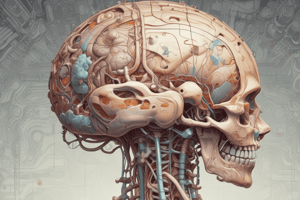Podcast
Questions and Answers
What is the primary function of motor nerves?
What is the primary function of motor nerves?
- To conduct impulses from the organs to the spinal cord
- To transmit information from the CNS to muscles (correct)
- To connect sensory and motor nerves
- To carry sensory information to the brain
What role do cranial nerves play in the nervous system?
What role do cranial nerves play in the nervous system?
- Conduct impulses to and from the spinal cord
- Connect sensory and motor nerves
- Transmit information directly to or from the brain (correct)
- Control involuntary body functions
Which system is responsible for the body's involuntary functions?
Which system is responsible for the body's involuntary functions?
- Autonomic nervous system (correct)
- Central nervous system
- Peripheral nervous system
- Somatic nervous system
What does the sympathetic nervous system primarily respond to?
What does the sympathetic nervous system primarily respond to?
What is the function of connecting nerves?
What is the function of connecting nerves?
What is the primary function of cerebral spinal fluid (CSF)?
What is the primary function of cerebral spinal fluid (CSF)?
Which part of the brain is responsible for coordinating voluntary and involuntary movements?
Which part of the brain is responsible for coordinating voluntary and involuntary movements?
Which lobe of the brain is primarily involved in vision?
Which lobe of the brain is primarily involved in vision?
What does the brain stem control?
What does the brain stem control?
Which layer of the meninges is the outermost and toughest?
Which layer of the meninges is the outermost and toughest?
Approximately how much CSF is contained in the brain at one time?
Approximately how much CSF is contained in the brain at one time?
What function is primarily associated with the frontal lobe?
What function is primarily associated with the frontal lobe?
What connects the cerebellum to every part of the central nervous system?
What connects the cerebellum to every part of the central nervous system?
What are the main components of the central nervous system?
What are the main components of the central nervous system?
Which part of a neuron primarily processes and integrates information?
Which part of a neuron primarily processes and integrates information?
Which of the following is a primary function of the nervous system?
Which of the following is a primary function of the nervous system?
What does the myelin sheath do for axons?
What does the myelin sheath do for axons?
What is gray matter primarily composed of?
What is gray matter primarily composed of?
What role do ganglia play in the nervous system?
What role do ganglia play in the nervous system?
Which structure protects the spinal cord?
Which structure protects the spinal cord?
What type of signal does the nervous system primarily use to maintain homeostasis?
What type of signal does the nervous system primarily use to maintain homeostasis?
Flashcards are hidden until you start studying
Study Notes
Anatomy of the Nervous System
- Skull and spinal canal provide robust protection against injury.
- Meninges consist of three layers: dura mater (outer layer, tough and fibrous), arachnoid, and pia mater (inner layers containing blood vessels).
- Cerebral spinal fluid (CSF) is produced in the third ventricle, with a volume of 125-150 mL, serving primarily as a shock absorber for the brain.
Structure of the Brain
- The brain is the control center of the body, divided into three major regions: cerebrum, cerebellum, and brain stem.
- Cerebrum:
- Makes up approximately 75% of total brain volume.
- Divided into two hemispheres, each containing four lobes:
- Frontal lobe: motor functions, personality, speech.
- Parietal lobe: language, temperature, pressure, touch.
- Temporal lobe: hearing, smell, language processing.
- Occipital lobe: vision.
- Surface features include gyri (bulging folds) and sulci (furrows).
Cerebellum and Brain Stem
- Cerebellum:
- Second largest brain part, coordinating voluntary and involuntary movements, maintaining posture.
- Brain Stem:
- Vital for life functions, controlling breathing, swallowing, heartbeat, and blood pressure.
- Best-protected area of the central nervous system (CNS).
Spinal Cord and Peripheral Nervous System
- Each spinal cord segment has left and right pairs of sensory and motor nerves linking it to the peripheral nervous system.
- Comprises 31 pairs of spinal nerves and 12 pairs of cranial nerves, involved in sensory and motor functions, with cranial nerves noted for special head and facial functions.
Types of Nerves
- Sensory Nerves:
- Transmit information to the brain from the body.
- Motor Nerves:
- Relay commands from the CNS to muscles.
- Connecting Nerves:
- Located in the brain and spinal cord, facilitating communication between sensory and motor nerves.
Autonomic Nervous System
- A subdivision of the peripheral nervous system, regulating involuntary functions (e.g., blood pressure, sweating).
- Divided into:
- Sympathetic Nervous System: Activates ‘fight or flight’ responses, increasing alertness, metabolic rate, heart rate.
- Parasympathetic Nervous System: Restores homeostasis, counteracting sympathetic actions.
Neurons and Nervous Tissue
- Neurons, the basic units of nervous tissue, consist of a cell body (nucleus and organelles) and an axon (output fiber).
- Axons may be myelinated, improving signal transmission efficiency.
- Dendrites receive signals from other neurons via synapses.
- Ganglia serve as relay points among different neurological structures.
CNS Structure
- Composed of the brain and spinal cord, processing impulses and determining responses.
- Gray Matter: Contains unmyelinated fibers; cannot regenerate if damaged.
- White Matter: Composed of myelinated fibers, forming the internal structure of the CNS.
- The entire CNS is shielded by protective coverings, ensuring safety against injury.
Studying That Suits You
Use AI to generate personalized quizzes and flashcards to suit your learning preferences.





